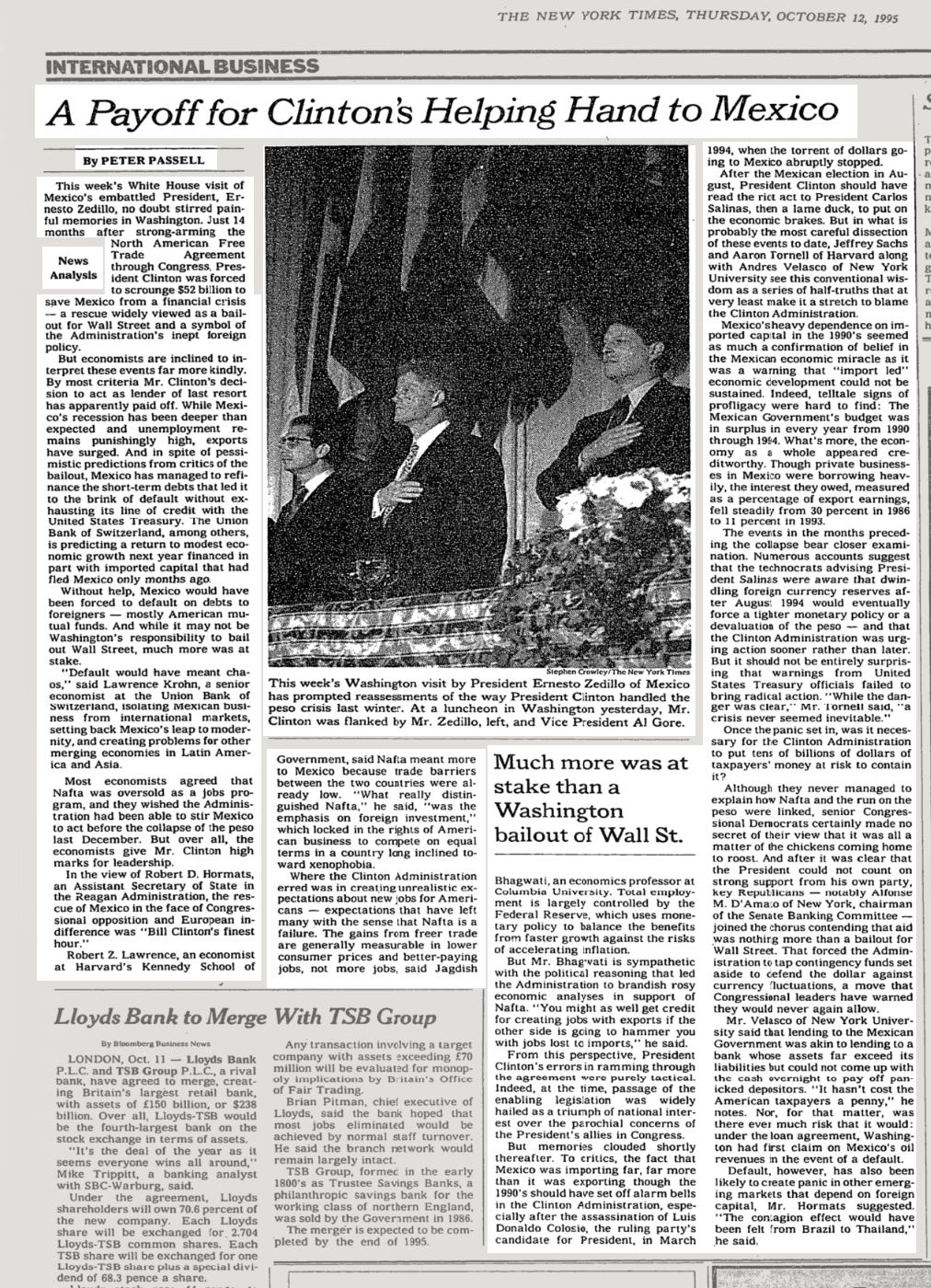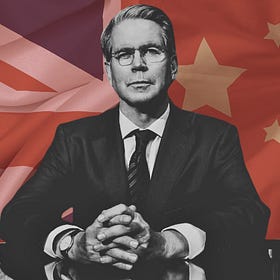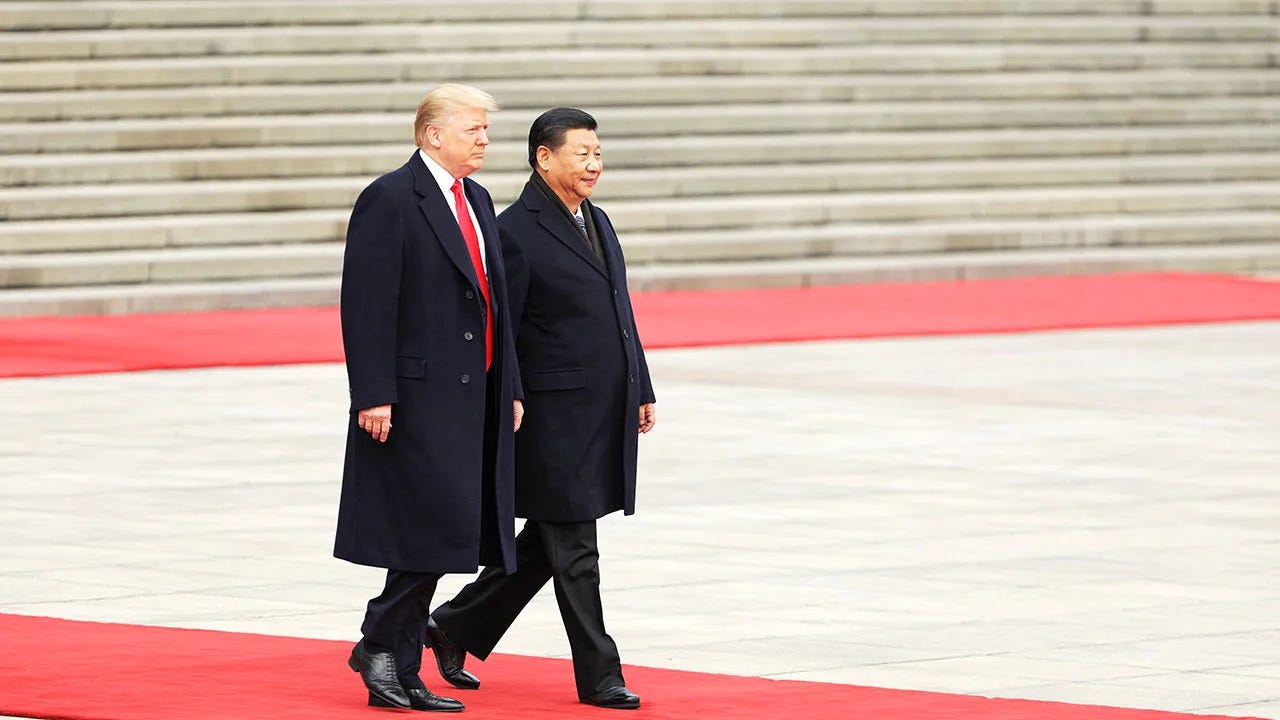The Media Got the Argentina "Bailout" Wrong — But It Still Sucks For US Soybean Farmers
Legacy media say Trump is favoring Milei over American farmers. But the $40B deal is actually a move against China's Latin American expansion—and everything could hinge on Thursday's Xi meeting
I want to talk about soybeans. I know, sexy topic, right? I mean, when was the last time you found yourself at a dinner party thinking, “You know what would really liven up this conversation? Agricultural commodities!” Wild times!
But sometimes the most important stories are wrapped in the most mundane packaging. And what’s happening to American soybean farmers right now? It’s a big deal not just for our economy, but for families across the Midwest who are watching their livelihoods evaporate in real time.
Besides, my YouTube algorithm started feeding me soybeans (get it 😉), and the general narrative was that Trump was undercutting American farmers because Argentina’s President, Javier Milei, is Trump’s bestie.
But before we dive in, let me set the table. This story is messy and complicated in ways that don’t fit neatly into a 270-character hot-take. Yes, our farmers are getting crushed. Yes, they deserve our attention and support. And yes, the China trade war needs to be resolved asap.
But, and this is a big but, sometimes the right strategic moves come with painful costs. Our soybean farmers have, unfortunately, once again borne the brunt of decisions aimed at something bigger: fortifying our national security and countering China’s aggressive expansion into our own hemisphere. This is something the previous administration ignored while China quietly built influence across Latin America.
So, when you hear the narrative from legacy media and the Left that Trump is just doing his buddy Milei a favor at farmers’ expense? That’s not the full picture. Not even close. What looks like favoritism on the surface, because that is all the legacy media has on a loop, is actually strategically important to national security and part of the Trump America First tenet.
Let’s give you the full picture because I know the media won’t.
The Eavesdrop That Exposed Everything
It’s late September 2025. The United Nations General Assembly in New York. World leaders, diplomats, the usual suspects. And then—click—an AP photographer captures something they probably shouldn’t have.

Treasury Secretary Scott Bessent is hunched over his phone, deep in a Signal chat with Agriculture Secretary Brooke Rollins. The photo is clear enough to read the message: “We bailed out Argentina yesterday... and sold a bunch of soybeans to China... This gives China more leverage on us.”
Talk about a peak over the shoulder to an inside view of geopolitics. And that one leaked text? It pulled back the curtain on a story that affects millions of American farmers and reveals just how tangled our global economic relationships have become.
Fast-forward to this Sunday. Argentina holds its midterm elections, and President Javier Milei—the chainsaw-wielding, libertarian firebrand who’s been trying to shock-therapy his country back to economic health- scores a massive landslide. His party jumps from 38 to around 60-70 seats in the lower house. The result? The full $40 billion U.S. deal gets unlocked, and Milei now has the governing power to push through his reforms.
And here’s the latest twist: Just this week, Trump announced he’s meeting with President Xi this Thursday in South Korea. According to Bessent’s appearance on Meet the Press, two days of negotiations with Chinese counterparts have already produced a framework for a trade deal, one that specifically includes soybean purchases. This is happening against the backdrop of Trump’s threatened 100% tariff set to kick in on November 1st, though Treasury Secretary Bessent says he doesn’t believe that hammer will actually need to fall.
Could Trump walk out of that meeting with a deal that finally gives soybean farmers some relief? It’s the kind of high-stakes, in-person negotiation that’s vintage Trump strategy—put maximum pressure on, then sit down face-to-face to cut a deal.
Before we go further, a question: Do you think the Argentina deal is a smart strategy or an expensive mistake? Keep that question in mind as we unpack this—I want your answer at the end.
Buckle up while I break down the drama of agricultural commodities. This story has all the suspense of tariffs, leaked texts, and enough geopolitical friction fit for a novel. We’ll circle back to that Xi meeting, but first, let’s understand how we got here.
The Argentina Angle: It’s Not About “The Bestie”
Let’s start with what’s got everyone fired up: the Argentina “bailout.”
Here’s what happened: In mid-October 2025, the Trump administration announced a $20 billion currency swap with Argentina through the Exchange Stabilization Fund (ESF). After Milei’s election victory, that deal is now set to double to $40 billion through coordinated private loans.
And yes, this is the same Argentina that’s been selling soybeans to China, undercutting U.S. farmers.
So, of course, left-leaning outlets have been hammering Trump for “favoring Argentina over U.S. interests,” painting it as cronyism toward Milei, who’s an open Trump admirer. The optics are brutal: leaked texts show officials worried about China gaining leverage, farmers are suffering, and we’re sending billions to a competitor?
But here’s what the critics are missing:
This isn’t actually a “bailout” in the traditional sense. It’s a repayable credit line from the ESF, a Treasury tool that’s been around since 1934. The ESF is self-funded (holding about $200-300 billion in assets) and doesn’t require annual congressional appropriations. It’s designed for exactly this kind of international financial stabilization.
Of course, the legacy media leaves out these details, along with the fact that a Democrat has done the same thing—Clinton’s 1995 loan to Mexico during the peso crisis. The U.S. provided a $20 billion ESF loan, bypassed Congress (which was deadlocked), and Mexico paid it back with interest. The loan stabilized the region, prevented economic collapse on our border, and the U.S. came out ahead financially.
The Argentina deal follows the same structure: A short-term bridge for reforms, not a handout. If it works, the U.S. gets repaid and gains a more stable, pro-American partner in South America. If it doesn’t... well, that’s the risk.
“It is America first because we are supporting a U.S. ally. There will be no taxpayer losses,” Bessent told NBC’s “Meet the Press.”
Why does this matter strategically?
Look at what’s been happening in our hemisphere while we’ve been distracted. Left-leaning and outright socialist governments have taken root across South America:
Venezuela: Full authoritarian socialism under Maduro, with a state-controlled economy and over $60 billion in debt to China
Cuba and Nicaragua: Repressive left-wing regimes
Brazil: Lula’s Workers’ Party promoting social programs (though vulnerable to shifts)
Colombia: Petro’s eco-socialism and reform agenda
Chile: Boric’s left coalition amid social unrest
And who is behind the curtain? China. Beijing has invested over $300 billion in the region since 2005 through the Belt and Road Initiative. They’ve built infrastructure, provided loans, and created dependencies—often called “debt traps”—that give them enormous leverage.
Enter Javier Milei: chainsaw-wielding, anarcho-capitalist economist who literally campaigned with a chainsaw as a symbol of cutting government waste. He’s won awards from conservative groups, gifted Elon Musk a chainsaw, and calls himself Argentina’s version of Trump. When he won his October landslide, markets rallied: peso up 5-7%, stocks up 10%. The question: Can this libertarian firebrand actually pull off what a century of Argentine leaders couldn’t?
Argentina under Milei represents a different path. He’s scrutinizing Chinese projects (like their military-linked space station), reducing reliance on yuan currency swaps, and aligning with the U.S. He’s requested NATO “global partner” status, buying F-16 jets instead of Chinese alternatives, and opening doors for American investment in Argentina’s massive lithium reserves—critical for our tech and EV supply chains.
Related:
Scott Bessent’s Economic Playbook - From Breaking the Bank of England to Trump’s Tariffs
In 1992, a young financial strategist named Scott Bessent helped orchestrate one of history's most legendary currency trades—a high-risk bet against the British pound that earned over $1 billion by exploiting a fatal economic weakness nobody else saw. Three decades later, as markets reel from Trump's "Liberation Day" tariff announcement, this same strategist—now Treasury Secretary Bessent—has emerged as the silver-haired voice of reason in a sharp suit, calmly steering America's economic battle plan.
Bessent calls it an “economic Monroe Doctrine.” It’s about having a pro-market, pro-American ally in a region where we’ve been losing ground for decades.
💡 THE STRATEGIC BET IN ONE SENTENCE: Spend $20-40B (repayable) to flip Argentina from China’s orbit to ours, securing lithium, countering socialism, and building a hemispheric ally, even if it stings farmers short-term.
And Milei’s economic record so far? Mixed but surprisingly promising:
Inflation crashed from 211% in 2023 to around 50% by mid-2025
GDP rebounded 6.3% in Q2 2025 after an initial recession
Argentina achieved its first budget surplus in 14 years
Poverty rates fell from 53% to around 35%
His October landslide gives him a stronger mandate to push reforms—tax cuts, labor overhauls, the works.
But here’s where it gets complicated. Economists at the Peterson Institute for International Economics (PIIE) argue that Argentina’s problems run deeper than short-term cash flow issues. They call it a “credibility trap.” Think quicksand—the more Milei struggles politically, the more markets panic about devaluation, which creates more political weakness. They point out Argentina’s reserves were actually negative $4.7 billion in mid-2025. As in: below zero. The peso might be overvalued, exports could become too expensive, and the whole thing might require recession-inducing interest rate hikes just to stay afloat.
Translation: The U.S. might be writing checks for years, not months.
Is it guaranteed to work? Time will tell. Argentina has defaulted nine times since its independence. But if Milei succeeds, the U.S. gets a repaid loan, a fortified ally, and a counter to Chinese expansion, all for an ESF swap that doesn’t directly tap taxpayers.
It’s not about favoring Milei because Trump likes him (though that rapport certainly helps). It’s about long-term positioning in a great power competition that’s been unfolding for decades.
What’s Actually Happening to Our Farmers
Pause here for a second. If you’re a farmer reading this, you’re probably thinking: “That’s great for geopolitics, but what about my actual bills?” Fair. Let’s talk about where this leaves you—and what Thursday might change.
American soybean farmers are the real victims here.
Soybeans are a massive crop in the United States. We’re talking a $40+ billion industry concentrated in Midwest states like Iowa, Illinois, and South Dakota. For generations, farmers in these regions have built their livelihoods around these beans. They’re a cornerstone of rural America.
And right now? They’re getting absolutely hammered. Exports to China: near-zero. Prices: tanking as surpluses pile up. Bankruptcies are rising across Iowa, Illinois, and South Dakota. Real families are losing multigenerational farms while fertilizer and equipment costs keep climbing.
Senator Chuck Grassley quoted frustrated constituents: “Farmers VERY upset... farmers need markets.” That’s diplomatic speak for: This is a disaster.
And here’s the frustrating part: These are self-inflicted wounds from the very tariffs meant to pressure China.
BY THE NUMBERS:
U.S. soybean exports to China 2025: ~$0
China’s Argentine soybean purchases: 7+ million metric tons
U.S. farm bankruptcies: Rising across Midwest
Days until Trump-Xi meeting: 2
And this brings us to a painful truth: Sometimes doing the necessary thing comes at a brutal cost. Our farmers didn’t ask to be on the front lines of a great power competition. But that’s where they’ve ended up.
Yes, it stings that Argentina is selling soybeans to China while we’re propping them up. The frustration is valid. But geopolitics is never clean. Sometimes you make uncomfortable bets on strategic partners, even when they’re competing with you economically in certain sectors, because the alternative—letting China completely dominate your hemisphere—is worse.
China’s Global Shopping Spree of South American Soybeans
Here’s where the trade war turns into a global shell game.
When the U.S. started slapping tariffs on Chinese goods back in 2018, and China hit back with a 25% duty on U.S. soybeans, Beijing didn’t just sit around waiting for us to blink. They went shopping in South America—specifically Brazil and Argentina.
In 2025 alone, China has booked millions of tons from Argentina: 1.575 million tons for September loading, 660,000 tons for October, and about 7 million metric tons overall. When Argentina scrapped its export taxes in September, China immediately purchased over a million additional tons.
It’s like China saying, “Thanks for the tariffs, we’ll just shop at the discount store next door while you lose market share.”
Here’s the scary part: This may not be temporary. When trading relationships shift like this, they often become permanent. Brazil has already captured market share that used to belong to U.S. farmers, and Argentina is following the same playbook.
The trade war has now escalated into what analysts are calling “round three.” And then China made a power play. October 2025: Export controls on rare-earth minerals, the lifeblood of electronics, EVs, and defense tech. It’s the economic equivalent of cutting brake lines. Trump’s response? A 100% tariff he called a “virtual embargo.” By October 18, markets were in freefall. The Dow: down 878 points. Then Trump blinked—sort of. Called the tariffs “not sustainable.” Opened the door to talks.
Translation: Maximum pressure, then negotiate. Classic Trump.
And as of this week, there’s been real movement. Trump’s scheduled to meet Xi this Thursday, with both sides having spent two days hammering out what he’s calling a framework for a trade deal—including specific provisions for soybean purchases. The November 1st deadline for those 100% tariffs? Bessent says they probably won’t be necessary.
Treasury Secretary Bessent has been in the thick of it, calling out China’s “state-driven economic practices” at the IMF meetings last month. He’s emphasized the U.S. is trying to de-escalate, but tensions remain high.
So who actually wins this trade war?
The honest answer? Nobody, really. Both sides bleed. But here’s the uncomfortable truth—China’s state-controlled economy can endure pain longer than our market democracy. They subsidize losses, control narratives, and weather public discontent. Meanwhile, U.S. farmers become news stories, and inflation becomes campaign ads.
That said, we’ve got leverage: tech dominance, dollar supremacy, and the ability to rally allies. If we hold firm, we might outlast Beijing’s patience. But right now? American farmers are taking the most incoming fire.
Déjà Vu: Lessons from 2018 — Sans Pandemic Disruption
This feels familiar because it is. In 2018, similar tariffs crashed soybean exports by 77%. The government spent $28 billion on farmer bailouts (criticized for going to big ag, not small farms). The Phase One deal in 2020 offered relief, but China fell short, and COVID scrambled everything before we could test the strategy.
So what’s different now? No pandemic disrupting the experiment. And something potentially bigger: Trump meets Xi this Thursday with a framework already in place. After 18 months of pain in 2018, could we see resolution in days instead of years? That’s the question keeping farmers up at night.
Based on history, expect continued price pressure but proposed bailouts ($10-14 billion from tariff funds) could stabilize incomes temporarily. Without a new deal, competitors like Argentina could capture more permanent market share, just like Brazil did after 2018 (U.S. global soy share dropped from 35% to under 30% by 2020). If negotiations succeed, a Phase One-style agreement might recover 20-40% of lost exports.
And here’s a separate philosophical tension that bugs fiscal conservatives: Proposed farmer bailouts are being discussed as coming from tariff revenue. This creates an uncomfortable cycle—tariffs hurt farmers, then tariff money bails them out, rather than paying down the national debt as originally intended. It feels like government dependency, which is counter to free-market solutions.
But in the context of a strategic competition with China, maybe it’s the cost of doing business.
Let’s Wrap It Up: The Messy, Complicated, and Maybe Necessary
Here’s what I keep coming back to: This story doesn’t have clean good guys and bad guys.
American soybean farmers are absolutely getting crushed. They’re bearing the brunt of a trade war they didn’t start, losing markets to competitors, and facing an uncertain future. They deserve more than platitudes. They need real solutions, and they need them soon.
At the same time, the strategic logic behind moves like the Argentina deal isn’t crazy. China has been making aggressive plays across Latin America for years, building influence through investments and loans that come with strings attached. Countering that requires building our own alliances, even if those allies sometimes compete with us economically.
The leaked text from Bessent and Rollins shows that even officials inside the administration know the Argentina-soy-China dynamic creates problems. But geopolitics is rarely clean. You don’t get to choose strategies with zero trade-offs.
The narrative that Trump is just helping his friend Milei out of personal loyalty? That’s too simplistic and frankly idiotic. Personal rapport helps, sure. But this is about hemispheric security, resource access, and countering Chinese expansion in our own backyard, which the previous administration ignored.
Does that make it any easier for the farmer in Iowa watching prices collapse? Hell no. And that’s the tragedy here. The people making sacrifices for these grand strategic moves are often the ones with the least say in the decisions.
Here’s what happens next. Trump’s meeting with Xi this Thursday could be the break farmers have been desperately waiting for. The fact that negotiators have already hammered out a framework, one that explicitly addresses soybean purchases, suggests this isn’t just photo-op diplomacy. And Bessent’s confidence that the November 1st tariff deadline won’t need to be triggered? That’s a signal that both sides might actually be ready to deal.
This is the frustrating classic Trump strategy, really. Apply maximum pressure (hello, 100% tariff threat), get everyone’s attention, then sit down in person and negotiate. It’s messier and more unpredictable than traditional diplomacy, but it sometimes works precisely because it keeps everyone off balance.
But let’s be clear: A framework isn’t a done deal. Frameworks collapse. Negotiations stall. Remember the Phase One agreement that China never fully honored? We’ve been down this road before. So cautious optimism is the order of the day.
If Trump does pull off a deal that reopens Chinese markets for soybeans, it would validate the “short-term pain for long-term gain” thesis that’s been so hard to swallow. Farmers would finally see relief. The strategic pressure would have worked. And maybe—maybe—the gamble on Argentina and the broader hemisphere strategy would look less contradictory and more like playing three-dimensional chess while everyone else was playing hopscotch.
But if talks fall apart? Farmers face another planting season with no market certainty, bailouts that feel like band-aids on a bullet wound, and the criticism that this entire approach has been too costly will only get louder as we approach midterms.
The next few days could tell us a lot. Either Trump’s hands-on, in-person approach delivers where traditional diplomacy failed, or we’re back to square one with farmers continuing to pay the price for a trade war with no end in sight.
What seems contrary to “America First” on the surface, propping up Argentina while they sell to China, threatening devastating tariffs, then negotiating, might actually be the most forward-thinking moves available.
Yes, critics like those at the Peterson Institute warn this could become an “expensive investment” with uncertain payoffs, especially if domestic backlash grows. That’s a legitimate risk. But if Milei’s reforms gain traction and the U.S. secures a reliable hemispheric ally while countering Chinese expansion, those long-term gains could validate the short-term costs.
But only if they work. And by this time next week, we’ll have a much better idea if this gambit pays off or goes off the rails.
Thanks for sticking with me through this soybean odyssey. I know it’s not the sexiest topic, but these are the issues that shape real lives and real communities.
If you’re a farmer or have skin in this game—whether through family, business, or just caring about where your food comes from—I want to hear from you. Has the trade war hit home? What should the administration do next? What am I missing?
Your input could shape how we think about these issues, and honestly, your perspective is probably more valuable than any pundit’s hot take. Please drop a comment below, and let’s talk about it.
Until next time—stay curious, stay skeptical, and don’t let anyone tell you complicated issues have simple answers.









This was super informative, and helped a lot in clearing the weeds, so thank you!
Thank you for taking the time to lay this all out. I really appreciate it!